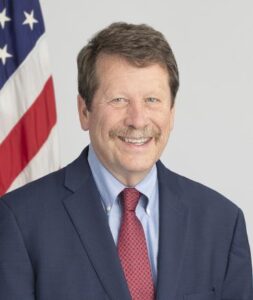WASHINGTON, D.C.—Problems with representativeness, disparities, algorithmic bias, the disruptive emergence of large language models and continued misinformation spread are key issues poised to transform patient care in American healthcare, U.S. Food & Drug Administration (FDA) commissioner Robert M. Califf, MD, said during a recent event.

Dr. Califf
Speaking at the Science of Patient Engagement Symposium organized by the National Health Council (NHC) in May, Dr. Califf noted these developments could harm patient care if they remain mostly unchecked by such channels as government agency scrutiny and federal regulation.
He especially warned about the potential pitfalls of large language models, such as ChatGPT. “If we’re not nimble in the use and regulation of large language models, we’ll be swept up quickly by something that we hardly understand,” Dr. Califf said during the event’s keynote speech, hosted by the National Press Club.
Dr. Califf also spoke in some detail about the other aforementioned key issues facing healthcare leaders, as patient involvement (either by patients themselves or their caregivers) and digital health “converge” as increasingly influential forces in the space.
Regarding representativeness, Dr. Califf said that although researchers can now interact with “almost the entire spectrum” of people facing a disease or at-risk for contracting it, “we will eventually need to address the diversity of values, preferences, beliefs, living circumstances and economic factors by directly measuring them in broader populations. The balance of benefits and risks can look quite different for a [new medical] product depending upon preferences that vary across a population.”
The ”dramatic” in the U.S. during the past few years is due not just to the oft-cited COVID-19 pandemic, gun violence, suicide and opioid overdoses, but also because of “the ongoing rise in chronic diseases and their sequalae, like stroke and heart attack,” he said. Research has revealed “stark” differences among rates of people suffering from these conditions by race, ethnicity, sex, education, rural living status and wealth.
“As a [retired] cardiologist, I thought we had solved this 20 years ago,” the 71-year-old former member of the FDA Cardiorenal Advisory Panel said of the rise in heart disease, in particular.
Innovators and technology drivers can help address this disparities trend, he added, by targeting new technologies at a larger swath of Americans. Primarily wealthy and well-educated people apply new technologies at first now, he said, suggesting others lack the access and/or ability to use them. “I urge you to think beyond the hypothetical or artificial laboratory-based assessment of how new drugs, devices and foods will be used across our society,” he told the audience.
“Algorithms,” he noted, can be problematic because they “evolve after they are put into practice. It is unlikely that an accurate algorithm will stay accurate when deployed in real life over time. It needs adjustment and measurement of its operating characteristics continuously throughout the life cycle. How do we get that done?” That adjustment and measurement are not getting done now, he added.
Dr. Califf cited large language models as an example. “I see the regulation of large language models as critical to our future,” he said, referencing ChatGPT. The artificial intelligence writing tool has emerged this year as a popular tool among consumers and technophiles alike, with some in healthcare espousing its transformative potential.
Despite his concern, Dr. Califf is bullish on the potential of this technology—if it is handled appropriately: “Large language models are that next step that appears to be ushering in the revolution many of us are hoping for,” he said. “Imagine a world in which your questions were answered immediately in a language appropriate for your literacy and numeracy; also your clinician can actually talk with you rather than spending all their time cutting, pasting and writing clinic notes; I could go on and on.”
Misinformation
Regarding the ongoing threat of health misinformation spread, which has been an acute problem, especially since the pandemic started, Dr. Califf cited his visit to South Carolina the previous weekend, when he attended a funeral with relatives. The time he spent with them in his home state reminded him of the discrepancy of information they are usually exposed to compared with what he typically consumes in Washington, D.C., where he works and lives.
Many emerging technologies threaten to expand problems with misinformation in the U.S., he said. For example: “Technologies like large language models give almost everyone the potential to produce false narratives or even so-called deep fakes—fabricated images and voices.”
Support Structures
Overall, “a key part of a successful transition to digital health is an effective regulatory scheme to guide digital technologies,” he said. “Across industry, digitization and insertion of machine learning and other types of mathematical algorithms into everyday life is making a profound difference, but government agencies lag behind private industry. Quite simply, we need to assemble the resources to put in place these policies and tools and adaptively align our digital health efforts to support public health and regulatory innovation.”
During a 30-minute presentation, Dr. Califf read from prepared remarks, but also went off-script and answered a few questions from an audience featuring other event speakers, healthcare policy leaders and patient advocates.
The FDA is “hyperaware of digital health changes,” he said. “But I think we are behind and it’s going to be really hard to catch up.”
Increasing patient engagement has changed research standards, Dr. Califf said, but not enough. He cited type 2 diabetes as an example, saying researchers should be able to someday survey 50 million people about their experiences with, and risk for, the disease. But they still cannot do so.
Do the Right Thing
The healthcare environment is a large part of the overarching problem, Dr. Califf concluded, with much of the U.S. system geared primarily toward generating revenues and pleasing shareholders instead of caring for patients. “Ninety-nine percent of people really want to do the right thing, but they exist in an environment where the outcomes of interest are financial profit-loss statements—even in not-for-profit health systems,” he said. “So box-checking becomes a fine art just like it does in any bureaucracy.”
“You just have to have the courage to seek out and identify lip service where it exists. The problem is lip service is in great abundance right now, not because people don’t want to do the right thing,” he added. Instead, this trend is largely due to job conditions preventing employees from doing so.
Although the agency is often lambasted and Dr. Califf himself has been called “crooked,” he noted that “we can take it at the FDA; we are used to being criticized, so keep us on our toes.” But he also urged the audience to hold health systems to the same ethical standards as such public agencies as the FDA. When a system sets up and touts a new clinic, for example, he encouraged viewers to question if its leaders are launching it primarily for money or to help patients. “Obviously [these leaders] have got to account for both,” he noted, “but have the courage to speak up.”
New technologies already allow researchers to collect more data more efficiently, including remote monitoring devices that improve patient access to and participation in clinical trials, he added. “Technological advances allow us to envision, explore and realize unprecedented new approaches for preventing and treating a wider range of previously untreatable diseases.”
Working in a healthcare space marked by such “rapid growth in technology and knowledge” has fostered a conundrum: There is “so much potential and also so much risk,” he said. “The digital world and understanding of how to engage people [is converging] in many ways. At the same time, this same convergence raises serious questions about our approach to clinical research, health and healthcare.”
In Sum
“If we want essential insights about what it is like to live with a disease, the outcomes that matter, and the adequacy of treatment options, we should ask people who are living with the problem or at risk of experiencing the problem — both patients and caregivers,” he said. “We should be able to design a more accurate, more complete benefit-risk framework that helps us to better evaluate the safety and effectiveness of a medical product across the vast expanse of patients and consumers with different values, educational levels and living and healthcare environments. We need to ensure that the experience of living with the disease is factored explicitly into development programs for all medical products, including measures of benefit and harms within clinical trials.”
Dr. Califf was sworn in as the FDA’s 25th commissioner in February 2022, after serving in the same role from February 2016–January 2017. He previously was the FDA’s deputy commissioner for medical products and tobacco, head of medical strategy and senior advisor at Alphabet Inc. and director of the Duke University Translational Medicine Institute, Durham, N.C., and Duke’s Clinical Research Institute. He earned his medical degree from Duke’s School of Medicine and completed his residency in internal medicine at the University of California-San Francisco and a cardiology fellowship at Duke.
The Patient Engagement Symposium is an annual event hosted by the NHC.
Ryan Basen is a journalist, writer and editor in Washington, D.C.

